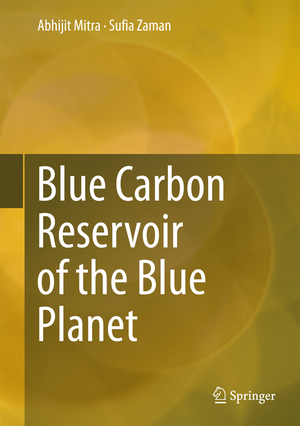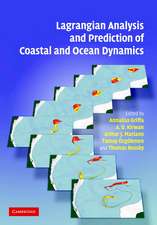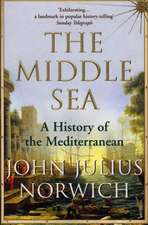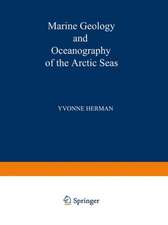Blue Carbon Reservoir of the Blue Planet
Autor Abhijit Mitra, Sufia Zamanen Limba Engleză Hardback – 6 feb 2015
| Toate formatele și edițiile | Preț | Express |
|---|---|---|
| Paperback (1) | 568.82 lei 38-45 zile | |
| Springer India – 12 oct 2016 | 568.82 lei 38-45 zile | |
| Hardback (1) | 655.60 lei 3-5 săpt. | |
| Springer India – 6 feb 2015 | 655.60 lei 3-5 săpt. |
Preț: 655.60 lei
Preț vechi: 771.30 lei
-15% Nou
Puncte Express: 983
Preț estimativ în valută:
125.45€ • 134.15$ • 104.60£
125.45€ • 134.15$ • 104.60£
Carte disponibilă
Livrare economică 28 martie-11 aprilie
Preluare comenzi: 021 569.72.76
Specificații
ISBN-13: 9788132221067
ISBN-10: 8132221060
Pagini: 500
Ilustrații: XII, 299 p. 383 illus., 360 illus. in color.
Dimensiuni: 178 x 254 x 20 mm
Greutate: 0.84 kg
Ediția:2015
Editura: Springer India
Colecția Springer
Locul publicării:New Delhi, India
ISBN-10: 8132221060
Pagini: 500
Ilustrații: XII, 299 p. 383 illus., 360 illus. in color.
Dimensiuni: 178 x 254 x 20 mm
Greutate: 0.84 kg
Ediția:2015
Editura: Springer India
Colecția Springer
Locul publicării:New Delhi, India
Public țintă
ResearchCuprins
Chapter 1: The Blue Zone of the Planet Earth.- Chapter 2: Biodiversity of the Blue Zone.- Chapter 3: Blue Carbon Assessment.- Chapter 4: Blue Carbon in Floral Community.- Chapter 5: Phytoplankton Carbon Stock.- Chapter 6: Blue Carbon in Faunal Community.- Chapter 7: Threats to Blue Carbon Reservoir.- Chapter 8: Road Map to Expand Blue Carbon Reservoir.
Notă biografică
Dr. Abhijit Mitra, Associate Professor and former Head, Dept. of Marine Science, University of Calcutta (INDIA) has been active in the sphere of Oceanography since 1985. He obtained his Ph. D as NET qualified scholar in 1994. Since then he joined Calcutta Port Trust and WWF (World Wide Fund for Nature-India), in various capacities to carry out research programmes on environmental science, biodiversity conservation, climate change and carbon sequestration. Presently Dr. Mitra is serving as the advisor of Oceanography Division of Techno India University, Kolkata. He has to his credit about 274 scientific publications in various National and International journals, and 26 books of postgraduate standards. Dr. Mitra is presently the member of several committees like PACON International, IUCN, SIOS, Mangrove Society of India etc. and has successfully completed about 16 projects on biodiversity loss in fishery sector, coastal pollution, aquaculture, alternative livelihood, climate change and carbon sequestration. Dr. Mitra also visited as faculty member and invited speaker in several Universities of Singapore, Kenya, Oman and USA. In 2008 Dr. Mitra was invited as visiting fellow at University of Massachusetts at Dartmouth, USA to deliver a series of lecture on Climate Change. Dr. Mitra also successfully guided 22 Ph.D students. Presently his research areas include environmental science, mangrove ecology, sustainable aquaculture, alternative livelihood, climate change and carbon sequestration.
Dr. Sufia Zaman, presently serving as Adjunct Assistant Professor in the Department of Oceanography in Techno India University (Kolkata) started her career in the field of Marine Science since 2001. She worked in the rigorous region of Indian Sundarbans and has wide range of experience in exploring the floral and faunal diversity of Sundarbans. She has published 1 book on carbon sequestration, 45 scientific papers and contributed chapters in several books on biodiversity, environmental science, aquaculture and livelihood development. Dr. Zaman is presently a member of Fisheries Society of India. She is also running projects on carbon sequestration by mangroves of Indian Sundarbans. She is the recipient of DST Women Scientist and Jawaharlal Memorial Doctoral fellowship awards. Her areas of research include aquaculture, fish nutrition, phytoplankton diversity, climate change and mangrove ecology. Dr. Zaman is also the first researcher in the maritime state of West Bengal (India), who initiated trial experiments on iron fertilization and subsequent enhancement of primary (phytoplankton) and secondary (fish) productions in the brackish water ponds of Indian Sundarbans with the financial assistance of Department of Science and Technology, Government of India.
Dr. Sufia Zaman, presently serving as Adjunct Assistant Professor in the Department of Oceanography in Techno India University (Kolkata) started her career in the field of Marine Science since 2001. She worked in the rigorous region of Indian Sundarbans and has wide range of experience in exploring the floral and faunal diversity of Sundarbans. She has published 1 book on carbon sequestration, 45 scientific papers and contributed chapters in several books on biodiversity, environmental science, aquaculture and livelihood development. Dr. Zaman is presently a member of Fisheries Society of India. She is also running projects on carbon sequestration by mangroves of Indian Sundarbans. She is the recipient of DST Women Scientist and Jawaharlal Memorial Doctoral fellowship awards. Her areas of research include aquaculture, fish nutrition, phytoplankton diversity, climate change and mangrove ecology. Dr. Zaman is also the first researcher in the maritime state of West Bengal (India), who initiated trial experiments on iron fertilization and subsequent enhancement of primary (phytoplankton) and secondary (fish) productions in the brackish water ponds of Indian Sundarbans with the financial assistance of Department of Science and Technology, Government of India.
Textul de pe ultima copertă
The ever increasing emission of carbon dioxide due to rapid industrialization, urbanization, unplanned tourism and alteration of land use pattern is causing unprecedented changes to marine biodiversity. Irrespective of political philosophy, nation, caste, sex and religion, mankind is under the appalling shadow of climate change. Today nature-based approaches for the mitigation of climate change are increasingly accepted as part of the low-cost solution. Thrust has been given by several scientific communities to assess the magnitude and viability of carbon sequestering potential of plants. Coastal producer communities like mangroves, salt marsh grass, sea grass beds, and seaweeds absorb atmospheric carbon dioxide during the process of photosynthesis. This carbon known as the ‘blue carbon’ is thus associated with the marine and estuarine ecosystems. However, a number of gaps in our scientific knowledge on blue carbon domain still exist. Molluscs, coral reefs, phytoplankton, which are amongst the important storehouses of carbon, have not been addressed. Very few scientific studies on the carbon stored in these valuable natural vaults have been performed, and no data bank is available on their carbon sequestering capacity on global basis.
The methodologies for assessing blue carbon stock also need further standardization so that credit from blue carbon reservoir is accepted by the International bodies in the form of a concrete policy. It is a matter of great appreciation that Conservation International (CI), the International Union for Conservation of Natural Resources (IUCN), and the Intergovernmental Oceanic Commission (IOC) of UNESCO is collaborating with governments, research institutions, non-governmental and international organizations, and communities around the world to develop management approaches, financial incentives and policy mechanisms for ensuring conservation and restoration of blue carbon ecosystems and implement projects around the world that demonstrate the feasibility of blue carbon accounting, management, and incentive agreements.
The present book has critically presented the data bank for each community of blue carbon not merely in the form of text description, but also through case studies that are the outcomes of research projects and pilot programmes.
The methodologies for assessing blue carbon stock also need further standardization so that credit from blue carbon reservoir is accepted by the International bodies in the form of a concrete policy. It is a matter of great appreciation that Conservation International (CI), the International Union for Conservation of Natural Resources (IUCN), and the Intergovernmental Oceanic Commission (IOC) of UNESCO is collaborating with governments, research institutions, non-governmental and international organizations, and communities around the world to develop management approaches, financial incentives and policy mechanisms for ensuring conservation and restoration of blue carbon ecosystems and implement projects around the world that demonstrate the feasibility of blue carbon accounting, management, and incentive agreements.
The present book has critically presented the data bank for each community of blue carbon not merely in the form of text description, but also through case studies that are the outcomes of research projects and pilot programmes.
Caracteristici
The present book is the first of its kind to scan critically the stored and sequestered carbon in coastal life forms and covers the following components Evaluation of the role of coastal biotic communities in mitigating rising carbon dioxide level 30 years research data on carbon sequestration and storage by coastal vegetation Emphasis on role of phytoplankton in carbon sequestration, carbon storage in coral reef ecosystem & molluscan community as a potential sink of carbon Includes supplementary material: sn.pub/extras








